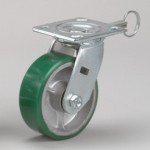So you have done your math and figured out the weight for the caster capacity. You have figured out, somewhat (and you’ll find out why I say somewhat in a few more lines) what type of material you need for your caster. You have also decided upon the type of swivel bearing you want. Now comes the curve ball! Certain types of caster materials do certain things. We have learned that some can do damage to certain surfaces such as iron or semi-steel casters and wheels have the high potential of marking up a hardwood floor, tearing carpet, and chipping, cracking, or crushing tile. So what are the features and advantages of some of these caster materials we have already discussed? Well, I’m going to cover some for you.
Polyolefin Wheel Casters are non-flattening with a 200% better impact strength than standard rubber wheels and are self lubricating.
Thermoplastic Rubber Casters are a non marking, soft cushioned caster which the thermoplastic rubber surrounds a rugged polypropylene hub.
Hi-Tech Polyurethane Casters are resistant to most solvents, chemicals, and acids as well as water. They have non-marking treads.
Pneumatic Casters are air filled and roll better when encountering uneven surfaces. However, please keep in mind, if the load is commonly heavy you will need to reconfigure the quantity of casters to use for your application unless you have chosen a larger pneumatic caster like an 8″ to 10″ wheel.
Now when you see Stainless Steel Casters, keep in mind they are not referring to the actual wheels, they are referring to the mount, swivel and connection. Stainless steel casters are mainly used for wet or corrosive environments such as hospitals, laboratories, and food processing plants.
We hope this has helped assist with your selection of casters and wheels. If you need further assistance with your decision and purchase please visit Bahrns.com the Material Handling and Equipment Company, your one source for materials handling and warehouse supplies.

